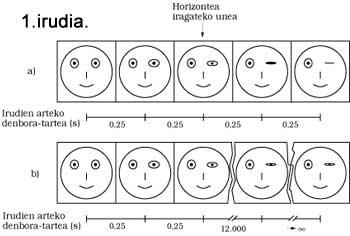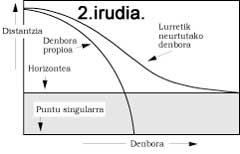Limit of black holes in the surrounding area (I)
The fact that to describe black holes their mass, the angular moment, and perhaps only requires charge, can lead us to consider them to some extent as a simple object. In any case, the image of black holes, which are invisible objects because they absorb everything around them and do not let the light escape, is too simple. Then we will try to complete a little this image by analyzing the structure of black holes. On this occasion we limit ourselves to those without rotation movement.
According to the image of the static black holes given by the theory of general relativity, these are spherical, but the material they ingest does not meet the total volume corresponding to Schuwarschils radio. Schwarzschill's radius is considered the limit of the black hole, since the matter that falls to the sphere defined by it cannot leave it, but this sphere is not filled with matter and does not have the surface as compact as it can have a neutron star or a planet.
The imaginary shell that defines Schwarzshild's radio is often called the horizon of the facts and, as we have said, it is just a limit. The matter that crosses it does not suffer any special effect. Once past the horizon of the facts, matter follows its journey and everything accumulates in the center of the sphere at an infinite point of density. Of course, this type of points generates great headaches to scientists and has been given a special name: the singular point. However, we will talk about this at the end, since we must clarify a little the nature of the horizon of the first events. For this we will continue to a hypothetical astronaut in his journey until diving into the black hole.
As is known, the theory of general relativity does not describe gravity as a force that is transmitted without contact. In Einstein's theory space and time form a unique whole and gravity is the result of the deformation that produces mass in the space-time geometry of its environment. Empty space/time without mass is totally flat, but if there is matter, the geometry of space/time is tilted and that inclination or curvature is the one that moves the masses.
As the space-time curvature decreases with distance, the influence on regions away from the black hole is low or almost zero. Therefore, our astronaut would have no problem in these regions to move freely. On the contrary, the closer the black hole, the more power should use the space engines if you would not want to remain still or fall into a place. However, the high power of the engine doesn't matter to us, because our trip has a black lens hole. However, if you want to travel through the black hole, the astronaut should think well of the black holes surrounding its space. You should choose a large black hole. Otherwise, the tide force created by the black hole would destroy space and its content. But let's explain this problem more slowly.

As is known, the force of gravity decreases depending on the distance to the mass that produces it. In the case of lower mass stars such as the Earth or the Moon, the effects of this dependence on the distance of force are not very violent, but at all negligible. For example, the tides caused by the Moon on Earth are due to the fact that the force of attraction of the Moon is greater than in the opposite of the Earth that looks at our satellite. If we consider that the astronaut is standing in space, the force that the black hole will attract the legs will be greater than the one that attracts the head.
Both in the ground and in the stars with mass and density of stars, although a few meters this difference is totally negligible, in the case of black holes can be enough to lengthen and crush the astronaut as a spaghetti. For example, let's think that the human body can't withstand stresses or pressures a hundred times higher than normal atmospheric pressure. In this case, in the black hole of 10 ms, whose radius would be 30 km, the astronaut would die 400 km above the horizon of events.
However, the intensity of the tidal forces depends on the density of the matter that produces them. Being the most massive black hole the density is smaller, the geometry of space/time will bend less and the maretic forces will be smaller. For example, the astronaut would have no problem crossing the horizon of a 1000 ms black hole.
After analyzing the view of the astronaut, we will then try to answer a new question: how would we see if that transit from Earth would be controlling the flight of space? To answer this question we must take into account that, according to the theory of general relativity, time does not equal for two observers who move with relative acceleration. Therefore, the time the astronomer would measure would not be the same as the one who would meditate on Earth.
The time that the observer who lives the event we want to analyze is called his own time and apparent time to others. For example, the time that measures the apparent time between two phenomena is always longer than that measured in proper time; the longer the relative acceleration is. Therefore, as the horizon of events passes, as space moves with a very high acceleration, although the time intervals measured by the astronomer are finite, those measured in apparent time would increase indefinitely. To better understand what is meant, let's think we've talked to the astronomer to make a gesture as we pass the horizon of events.
In Figure 1(a), you can see how a camera in space would record the gesture. As seen, the third photograph is the one that corresponds to the step and nothing special happens. In section b) you can see how we would receive the recording on Earth, that is, the images we would receive by measuring the same apparent intervals. At first, what we would see on our screen and the sequences of section a) would be the same, but as space approaches the horizon, the images that we would receive at the same time intervals would be almost equal, since the astronaut would teach us the time when the horizon crosses. Somehow, time and images freeze. The two photos after the horizon would never arrive, of course, because of the black hole nothing can be removed. In other words, the images that come out of the contour of the black hole, or finally the radiations, are obtained with an increasingly apparent frequency. Therefore, in addition, the radiation moves towards the red, loses energy and the intensity in the image is increasingly weak.

The curve “Time measured from the earth” of figure 2 also indicates what we have just explained. The other curve represents one's own time and, as seen, it still does not experience any change, even after getting into the black hole (represented by scratching in the image). It is observed that the essential journey to singularity also occurs in a finite own time. For example, for a black hole of 10 ms, that time would only be of famine of a second, and for one who would be formed in the nucleus of a galaxy would also be of an hour. However, when we speak of questions within black holes, we must take into account that the singular point which predicts the theory of general relativity is a very special and incomprehensible point in which our theory loses all its capacity to describe what predicts or some situation. For this reason, many consider that the dynamics within the black hole cannot be studied with a minimum base while Einstein's theory does not develop taking into account the principles of quantum mechanics, that is, while quantum gravitation is not developed.
ANNIVERSARIES SUN: April 20, 1 h 49 min (UT) enters Taurus.
PLANETS
|
Buletina
Bidali zure helbide elektronikoa eta jaso asteroko buletina zure sarrera-ontzian











